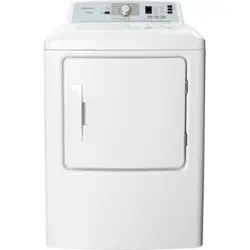Documents: Go to download!
User Manual
- User Manual - (English)
- Quick Specs - (English)
- Warranty- English, Francais - (English)
- Features
- INSTALLATION INSTRUCTIONS
- Unpacking your dryer
- Choosing a location
- Installing your dryer
- Using your dryer
- Maintaining your dryer
- Troubleshooting
Table of contents
User manual Electric Dryer
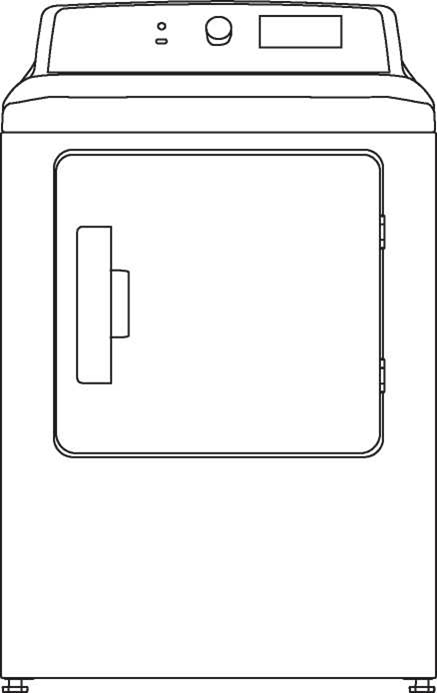
Features
Package contents
• 6.7 Cu. Ft. Front-Load Electric or Gas Dryer
• User Guide
Front components

INSTALLATION INSTRUCTIONS
Back components
Electric Dryer
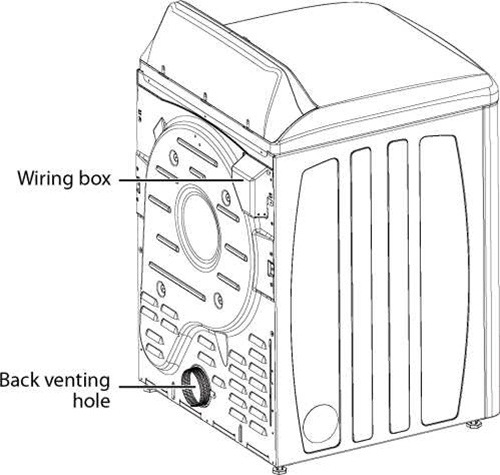
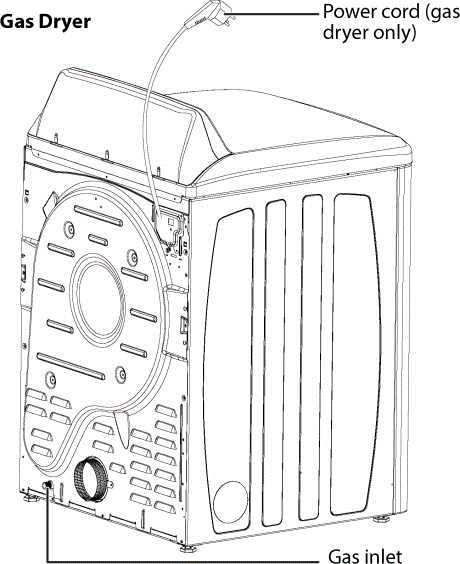
Control panel
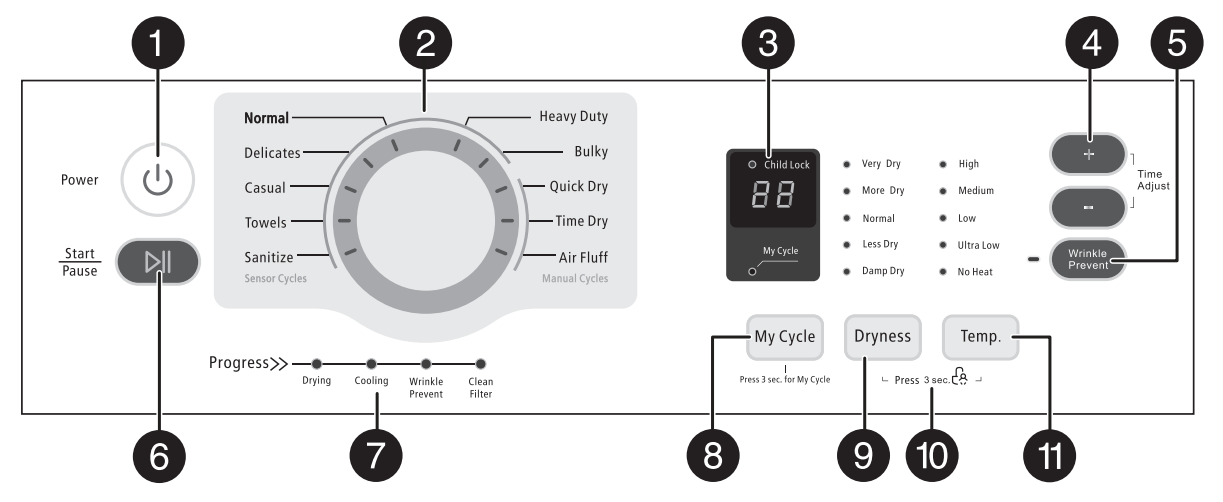
# | ITEM | DESCRIPTION |
1 |
| Press to turn your dryer on or off. If your dryer is on for more than 10 minutes without any buttons being pressed, it automatically turns off. |
2 | Cycle selector | Turn to select the cycle for the type of load. The cycle you select determines the heat control for the cycle. The Normal, Delicates, Casual, Towels, Sanitize, Heavy Duty, and Bulky cycles are Sensor Dry cycles. The Quick Dry, Time Dry, and Air fluff cycles are Manual Dry cycles. For more information, see Dryer options and settings on page 24. |
3 | Digital display | Displays the time while you are pressing the -Time Adjust + button to set the time for the Quick Dry, Time Dry, or Air fluff cycle. Displays the remaining cycle time while your dryer is running. |
4 | -Time Adjust + button | Press repeatedly to select the drying time. This button only works for the Quick Dry, Time Dry, and Air fluff cycles. |
5 | Wrinkle Prevent button | Press once to add the Wrinkle Prevent step to the drying cycle. Press again to cancel. Wrinkle Prevent provides approximately 90 minutes of intermittent tumbling in unheated air at the end of the cycle to reduce wrinkling. The load is already dry and can be removed at any time during the Wrinkle Prevent cycle. |
6 |
| Press to start or pause the drying cycle. When you pause the cycle, you can add items to the dryer, but your cannot change any settings. |
7 | Cycle status indicators | Indicate what stage in the drying cycle your dryer is in. For example, when your dryer is in the cooling down stage of the cycle, the Cooling indicator lights. When the cycle is complete, the Clean Filter indicator flashes to remind you to clean the filter. |
8 | MY CYCLE button | Press and hold for three seconds to save your favorite drying cycle. Press once to load your favorite cycle setting. |
9 | Dryness button | Press to select the dryness level. Different dryness levels result in different drying times. For clothes to be ironed manually, select a lower dryness level. For more information, see Dryer options and settings on page 24. |
10 | Child lock | Press and hold the Dryness and Temp buttons at the same time for three seconds to turn on the child lock function. Press and hold for three seconds to turn off the function. When the child lock function is turned on, the only button that works is the POWER button. |
11 | Temp button | Press to select the drying temperature. Your can select High, Medium, Low, Ultra Low, or No Heat. Temperature changes are only available on Quick Dry and Time Dry settings. For more information, see Dryer options and settings on page 24. |
Unpacking your dryer
WARNING:
• Packing materials can be dangerous to children. Keep all packing materials (such as plastic bags and polystyrene) well out of the reach of children.
• Do not operate your dryer on the foam base cushion. Doing so will result in serious vibration, which could cause equipment damage or result in physical injury.
• Unpack your dryer and inspect it for shipping damage. Make sure that you have received all the items shown in Package contents on page 5.
• To prevent personal injury or strain, wear protective gloves and use a furniture mover whenever lifting or carrying your dryer.
Choosing a location
Important to installer:
Read the following instructions carefully before installing the dryer. These instructions should be kept for future reference.
• The dryer is not suitable for installation in a mobile home.
• Remove the door from all discarded appliances to avoid the danger of a child being trapped and suffocating.
• After unplugging a discarded appliance, cut off the power cord.
• Provisions for introduction of outside air into the dryer room. The free area of any opening for the introduction of outside air shall not be less than twice the area of the dryer exhaust outlet.
WARNING: Your dryer must be exhausted to the outside to reduce the risk of fire when installed any place inside the house.
You should locate your dryer where there is enough space at the front for loading the dryer and enough space behind for the exhaust system.
Your dryer is factory-ready for the rear exhaust option.
Make sure that the room you install your dryer in has enough fresh air and that there are no air-flow obstructions.
Do not install or store your dryer in an area where it will be exposed to water or weather. Keep the dryer area clear of combustible materials, gasoline, and other flammable vapors and liquids. Your dryer produces combustible lint. Keep the area around the dryer lint-free.
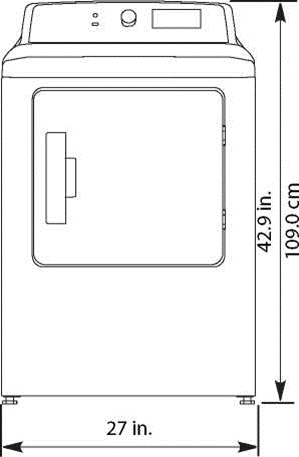
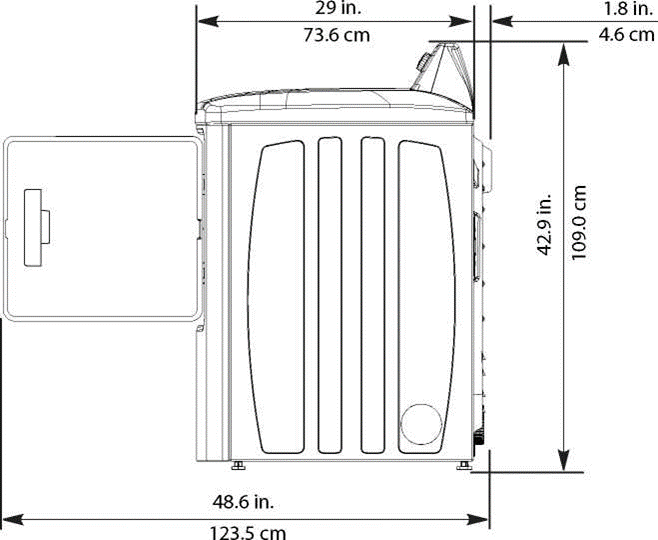
Installing your dryer and washer side-by-side
Leave at least one inch between your appliances and from any surrounding walls. If your washer is a top-loading washer, make sure that you have enough room to open the washer lid.
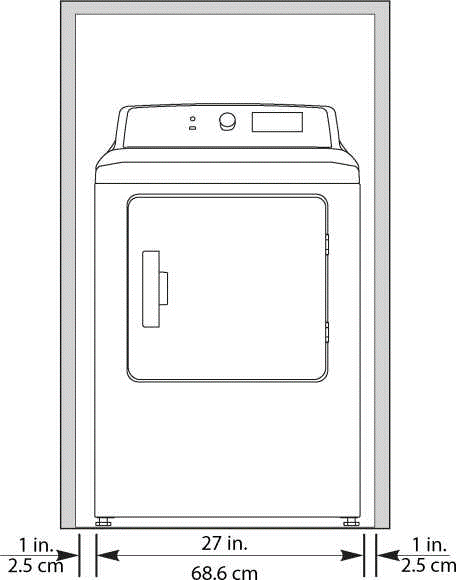
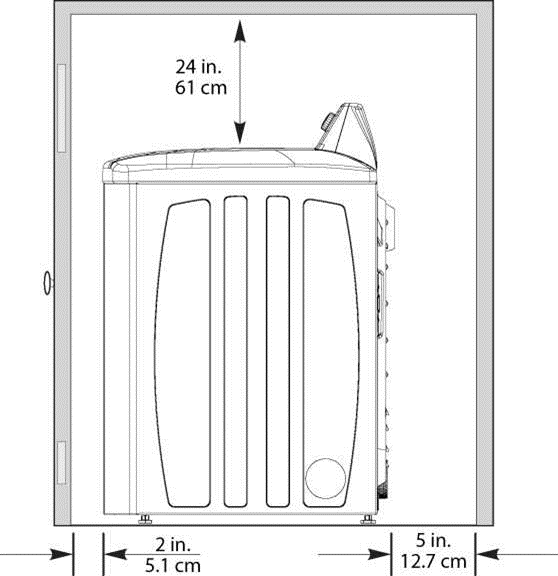
Installing in an alcove, closet, or wall insert/recessed
WARNING:
• You must exhaust your dryer to the outside to reduce the risk of fire when installed any place inside the house.
• Do NOT install another fuel-burning appliance in the same closet as your dryer.
For information about how to select and install exhaust ducts, see Exhausting requirements on page 11.
If you install your dryer in an alcove, closet, or wall insert/recessed, the front of the closet must have two unobstructed air openings for a combined minimum total area of 72 sq.in. (465 sq.cm) with a minimum clearance of 3 in. (7.6 cm) at the top and bottom. A slatted door with equivalent space clearance is acceptable.
Minimum clearances between your dryer and adjacent walls or other surfaces are:
• Either side: 1 in. (2.5 cm)
• Rear: 5 in. (12.7 cm)
• Top: 24 in. (61 cm)
• Front: 2 in. (5.1 cm)
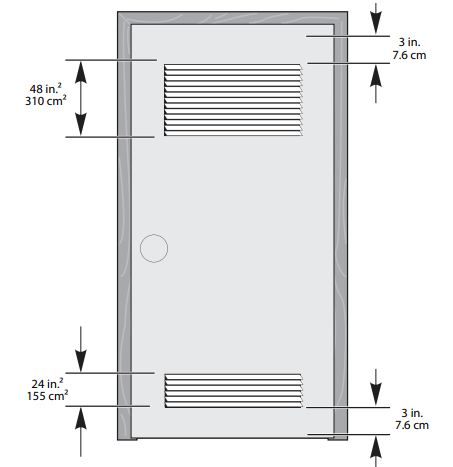
Exhausting requirements
WARNING:
Do not exhaust your dryer into a chimney, a wall, a ceiling, an attic, a crawl space, or a concealed space in a building.
Your dryer must be exhausted to the outside to reduce the risk of fire when installed in an alcove or closet. Exhausting the dryer to the outside prevents large amounts of lint and moisture from being blown into the room.
WARNING:
NEVER USE A PLASTIC OR NON-METAL FLEXIBLE DUCT
• If your existing duct work is plastic, non-metal, or combustible, replace it with metal.
• Use only a metal exhaust duct that is non-flammable to ensure containment of the exhaust air heat and lint.
• Do not assemble the duct with screws or other fasteners that extend into the duct or that catch lint.
• The exhaust duct should be 4 in. (10.2 cm) in diameter.
• The total length of flexible metal duct should not exceed 7.8 ft. (2.4 m).
• Use only those foil-type flexible ducts, if any, specifically identified for use with your dryer by the manufacturer.
• In the U.S., make sure that the ducts comply with the outline for Clothes Dryer Transition Ducts, Subject 2158A. See Ducting requirements on page 12 for the maximum duct length and number of bends.
Ducting requirements
WARNING:
- You are responsible for correctly installing the exhaust system.
- Use a 4-inch (10.2 cm) diameter rigid aluminum or rigid galvanized steel duct. Do not use a smaller duct.
- Ducts larger than 4 inches (10.2 cm) in diameter can result in increased accumulation of lint.
- Lint should be removed regularly.
- If you must use a flexible metal duct, use the type with a stiff sheet metal wall. Do not use a flexible duct with a thin foil wall. A serious blockage can result if the flexible metal duct is bent too sharply.
- Never install any type of flexible duct in walls, ceilings, or other concealed spaces.
- Keep the exhaust duct as straight and short as possible.
- Secure joints with duct tape. Do not use screws.
- Plastic, flexible ducts can kink, sag, be punctured, reduce airflow, extend drying times, and affect your dryer’s operation.
- Exhaust systems longer than recommended can extend drying times, affect dryer operations, and collect lint.
- The exhaust duct should end with an exhaust hood that has a swing-out damper to prevent back drafts and entry of wildlife. Never use an exhaust hood with a magnetic damper.
- The hood should have at least 12 inches (30.5 cm) of clearance between the bottom of the hood and the ground or other obstruction. The hood opening should point down.
- Never install a screen over the exhaust outlet.
- To avoid lint buildup, do not exhaust the dryer directly into a window well.
- Do not exhaust under a house or porch.
- If the exhaust duct must run through an unheated area, the duct should be insulated and slope slightly down towards the exhaust hood to reduce condensation and lint buildup.
- Inspect and clean the interior of the exhaust system at least once a year.
- Unplug the power cord before cleaning.
- Check frequently to make sure that the exhaust hood damper opens and closes freely.
- Check once per month, and clean at least once per year. Note: If your clothes are not getting dry, check the ducting for obstructions.
- Do not exhaust the dryer into a wall, ceiling, crawl space, or concealed space of a building, gas vent, or any other common duct or chimney. This could create a fire hazard from the lint expelled by the dryer.
- Do not use non-metallic flexible ducting.
- To reduce the risk of fire, your dryer MUST BE EXHAUSTED OUTDOORS.
Measuring and verifying system back pressure
A Dryer
B 10 in. (25.4 cm) minimum of straight pipe-measure back pressure from the center
C To vent system
D Location on back pressure measurement
E Inclined manometer
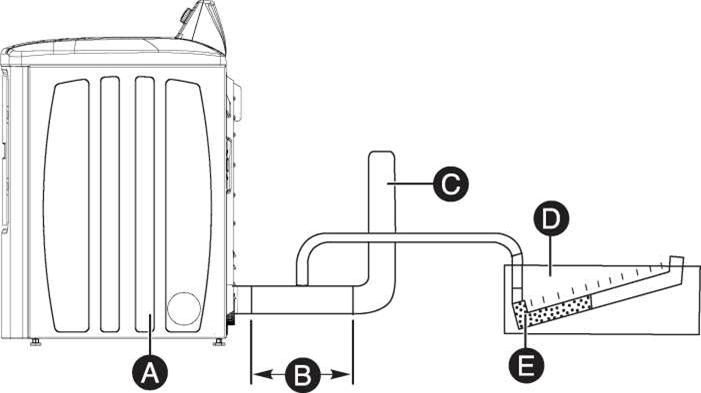
To measure the system back pressure:
1 Make sure that your dryer is empty and working.
2 Place the manometer at the point where the exhaust duct connects to the dryer.
3 Make sure that the lint filter is clean.
4 Set your dryer to the no-heat setting, then turn on your dryer.
Exhaust hood types
If you install your dryer into an existing exhaust system you must make sure that:
• The exhaust system meets all local, state, and national codes.
• You do not use a flexible plastic duct.
• You inspect and clean all lint buildup from inside the existing duct.
• The duct is not dented or crushed.
• The exhaust hood damper opens and closes freely.
For best results, the static pressure in any exhaust system should be between .3 to .8 inches of water column, and it cannot be less than 0 under any circumstances with an installed duct with a four inch diameter.
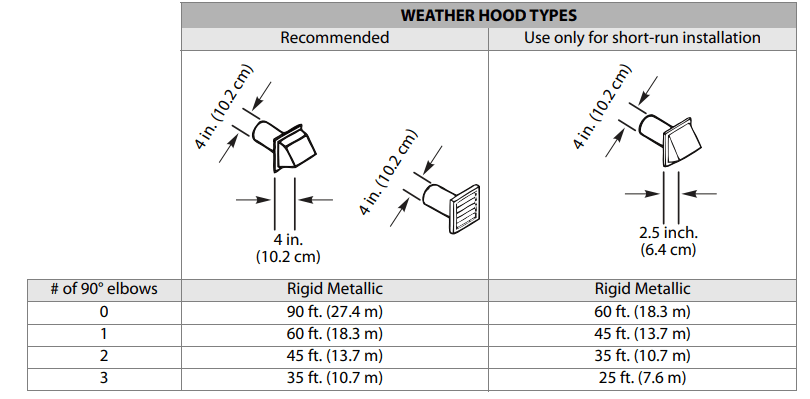
Electric requirements—Canada only
Note: For products sold in Canada, your dryer has a power cord with an equipment-grounding conductor and a grounding plug.
WARNING:
• The power cord plug must be plugged into an appropriate outlet that is properly installed and grounded in accordance with all local codes and ordinances.
• Do not modify the plug provided with your dryer. If the plug does not fit the outlet, have a proper outlet installed by a qualified electrician.
• If you permanently wire your dryer instead of using a power cord, your dryer must be connected to a permanently grounded metal wiring system, or an equipment grounding conductor must be run with the circuit conductors and connected to the equipment grounding terminal or lead on the dryer.
• You need a 120/240 volt, 60Hz AC approved electrical service fused through a 30-ampere fuse or circuit breaker on both sides of the line.
• All Canadian models are shipped with the power cord attached. The power cord should be plugged into a 30-ampere receptacle.
• In Canada, you may not convert a dryer to 208 volts.
Electric requirements—U.S. only
Note: For products sold in the U.S., your dryer has an optional cord with an equipment grounding conductor and a grounding plug, which is sold separately.
WARNING:
• The power cord plug must be plugged into an appropriate outlet that is correctly installed and grounded in accordance with all local codes and ordinances.
• If you permanently wire your dryer instead of using a power cord, your dryer must be connected to a permanently grounded metal wiring system, or an equipment grounding conductor must be run with the circuit conductors and connected to the equipment grounding terminal or lead on the dryer.
Most dryers require a 120/240 volt, 60Hz AC approved electrical service. Some require 120/208 volt, 60Hz approved electrical service. The electric service requirements can be found on the data label located behind the door. A 30-ampere fuse or circuit breaker on both sides of the line is required.
• If you use a power cord, you should plug the cord into a 30-ampere receptacle.
• A power cord is NOT provided with U.S. electric model dryers.
WARNING:
RISK OF ELECTRIC SHOCK:
When local codes allow, the electrical supply of your dryer may be connected by means of a new power supply cord kit, marked for use with a dryer, that is UL listed and rated at a minimum of 120/240 volts, 30-ampere with three No. 10 copper wire conductors terminated with closed loop terminals, open-end spade lugs with turned up ends, or with tinned leads.
• Do not reuse a power supply cord from an old dryer. The power cord electric supply wiring must be retained at the dryer cabinet with a suitable UL-listed strain relief.
• Grounding through the neutral conductor is prohibited for (1) new branch-circuit installations, (2) mobile homes, (3) recreational vehicles, and (4) areas where local codes prohibit grounding through the neutral conductor. (Use a four-prong plug for four-wire receptacles, NEMA type 14-30R.)
Power outlet types
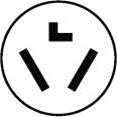
Three-wire outlet (10-30R)
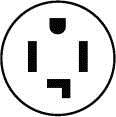

Using a three-wire outlet
If your outlet is a three-wire (three-prong) outlet, choose a three-wire power supply cord with ring or spade terminals and UL listed strain relief. The three-wire power supply cord must:
• Be at least 4 ft. (1.22 m) long
• Have three 10-gauge solid copper wires
• Match a three-wire outlet of NEMA Type 10-30R.
See Step-bv-Step instructions on page 16 for instructions on how to connect a power cord to your dryer.
Using a four-wire outlet
If your outlet is a four-wire (four-prong) outlet, choose a four-wire power supply cord with ring or spade terminals and UL listed strain relief. The four-wire power supply cord must:
• Be at least 4 ft. (1.22 m) long
• Have four 10-gauge solid copper wires
• Match a four-wire outlet of NEMA Type 14-30 R. The ground wire (ground conductor) may be either green or bare. The neutral conductor must be identified by a white color.
See Step-by-Step instructions on page 16 for instructions on how to connect a power cord to your dryer.
Grounding requirements
Your dryer must be grounded. If a malfunction or breakdown occurs, the grounding reduces the risk of electrical shock by providing a path of least resistance for the electrical current. This appliance is equipped with a cord having an equipment-grounding conductor and a grounding plug. The plug must be plugged into an appropriate outlet that is properly installed and grounded in accordance with all local codes and ordinances.
WARNING:
The wiring diagram is located on the back board of your dryer.
• Incorrectly connecting your dryer's grounding conductor can result in electric shock. Check with a qualified electrician or serviceman if you are in doubt as to whether your dryer is correctly grounded.
• Do not modify the plug provided with your dryer. If the plug does not fit the outlet, have the correct type outlet installed by a qualified electrician.
• To prevent unnecessary risk of fire, electrical shock, or personal injury, all wiring and grounding must be done in accordance with local codes, or in the absence of local codes, with the National Electrical Code, ANSI/NFPA No. 70 - Latest Revision (for the U.S.) or the Canadian Electrical Code CSA C22.1-Latest Revisions and local codes and ordinances (for Canada).
• You are responsible for providing adequate electrical services for your dryer.
All gas installations must be done in accordance with the National Fuel Code
• ANSI/Z2231 - Latest Revision (for the U.S.) or CAN/CGA - B149 Installation Codes - Latest Revision (for Canada) and local codes and ordinances.
• Gas dryers installed in residential garages must be raised 18" (46 cm) above the floor.
• Additionally, a 1/8" (0.3 cm) N.P.T. (National Pipe Thread) plugged tapping, accessible for test gauge connection, must be installed immediately upstream of your dryer's gas supply connection.
• The dryer must be disconnected from the gas supply piping system during pressure testing at pressures greater than 1/2 psi (3.5 kPa).
• On dryers not equipped with a gas union in the dryer manifold, the instructions shall specify that a listed connector in compliance with the Standard for Connectors for Gas Appliances, ANSI Z21.24 - CSA 6.10 be used to connect the dryer to the supply piping.
Installing your dryer
Tools you will need

Materials you will need
• 3/8" Gas Dryer Install Kit (Gas model only)
• 3 or 4-prong (dependent on owners house) Electric Kit. (electric model only)
• Exhaust kit
Before you start
Before you start installing your dryer, make sure that:
• The location you selected has a grounded electrical outlet. See Grounding requirements on page 15.
• For U.S. models, you have the correct type power cord (not included). See Electric requirements—U.S. only on page 13.
Note: For Canadian models, the power cord comes pre-installed.
• Your exhaust ducting (not included) is made of rigid metal or flexible stiff-walled metal. See Ducting requirements on page 12.
• You have a 3/8" Gas Dryer Install Kit (if you are installing a gas dryer) must meet all national and local codes.
Step-by-Step instructions
Note: If a gas dryer is being installed, you will need to call a licensed professional to do the installation.
Step 1: Make sure that the floor is a solid, level surface
• Use a level to make sure that the floor where you are installing your dryer is level. This helps minimize vibration, noise, and unwanted movement.
Step 2: Move your dryer to the location you selected
• Move your dryer to the location you selected, but do not push your dryer all the way back into the location. You need to connect the power cord and ducting before you move your dryer into its final position.
Tip: ion about space requirements for a side-by-side installation, see Installing your dryer and washer
side-by-side on page 10.
Step 3: Connect the exhaust ducting
Important: Before you connect the exhaust ducting, review ducting requirements in Ducting requirements on page 12.
WARNING:
• Make sure that your dryer is installed properly so it exhausts air easily.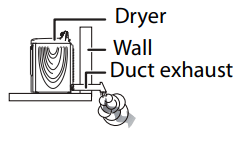
• Keep ducts as straight as possible. 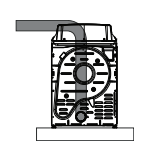
• DO NOT restrict your dryer with a poor exhaust system. 
• DO NOT use unnecessarily long ducts that have many elbows. 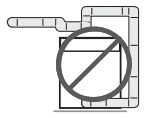
• DO NOT use plastic flexible exhaust material. 
• Use a 4 in. (10.2 cm) diameter rigid metal duct. Tape all joints, including at the dryer.
• DO NOT use sheet metal screws that can accumulate lint when assembling the ducting. Joints should be taped.
• DO NOT let the duct tape cover the ventilation slots on the back of your dryer.
• Clean all old ducts before installing your new dryer. Be sure the vent flap opens and closes freely. Inspect and clean the exhaust system annually.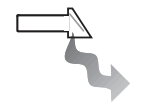
• DO NOT use a plastic, thin foil, or non-metal flexible duct.
• DO NOT use dented or clogged ducts and vent.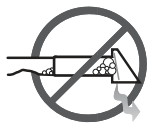
1 Make sure that the exhaust hood flapper or louvers move freely.
If you do not have an exhaust hood installed, see Exhaust hood types on page 12 for information about recommended hood types. We recommend that you have a professional install the exhaust hood.
2 Connect one end of the exhaust ducting to your dryer, then use duct tape to secure the ducting to your dryer. The crimped ends of the duct sections must point away from your dryer. Use a 4 in. (10.2 cm) diameter rigid metal duct.
3 Connect the other end of the ducting to the exhaust hood. Tape all joints, including at the dryer.
Step 4: Connect the power cord (U.S. models only)
Important: Before you connect the power cord, review the electric requirements in Electric requirements—U.S. onjy on page 13.
Before testing or operating your dryer, make sure that your dryer is grounded. See Grounding requirements on page 15.
• Determine whether your electric outlet is a three-wire or four-wire outlet. See Power outlet types on page 14. Three-wire outlet:
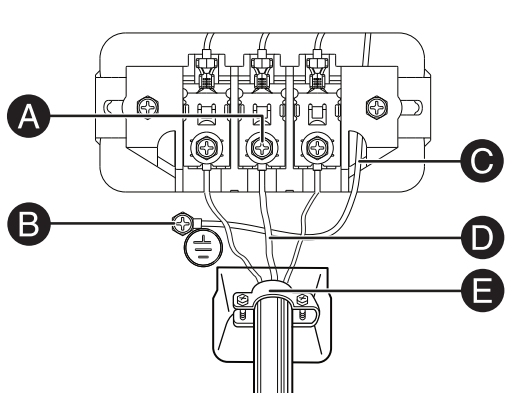
A Center terminal block screw
B External ground connector
C Neutral grounding wire (white)
D Neutral wire (white or center wire)
E 3/4" (1.9 cm) UL-listed strain relief
1 On your dryer, remove the center terminal block screw (A).
2 Connect the neutral wire (white or center wire) of the power cord to the center terminal screw of the terminal block. Be sure to cross the screw through the ring of the power cord terminal and tighten the screw.
3 Connect the other wires to the outer terminal block screws. Be sure to cross the screw through the terminal ring and tighten the screw.
4 Tighten the strain relief screws.
5 Insert the tab of the terminal block cover into your dryer's rear panel slot, then secure the cover with a screw.
WARNING: If your are converting from a 4-wire electrical system to a 3-wire, you must reconnect the ground strap to the terminal block support to ground the dryer frame to the neutral conductor.
Four-wire outlet:

A Center terminal block screw
B External ground connector
C Green or bare copper wire of the power cord
D Neutral grounding wire (White)
E Neutral wire (white or center wire)
F 3/4" (1.9 cm) UL-listed strain relief
1 Remove the center terminal block screw.
2 Connect the ground wire (green or unwrapped) of the power cord to the external ground conductor screw.
3 Connect the neutral wire (white or center wire) of the power cord and the appliance ground wire (white) under the center screw of the terminal block.
4 Connect the other wires to the outer terminal block screws. Be sure to cross the screw through the terminal ring and tighten the screw.
5 Tighten the strain relief screws.
6 Insert the tab of the terminal block cover into your dryer's rear panel slot, then secure the cover with a screw.
Step 5: Level your dryer
• If your dryer is not level, carefully tilt your dryer just enough to adjust the leveling feet on the bottom of your dryer. Extend the feet only as much as is necessary. If the feet are extended too much, your dryer may vibrate.
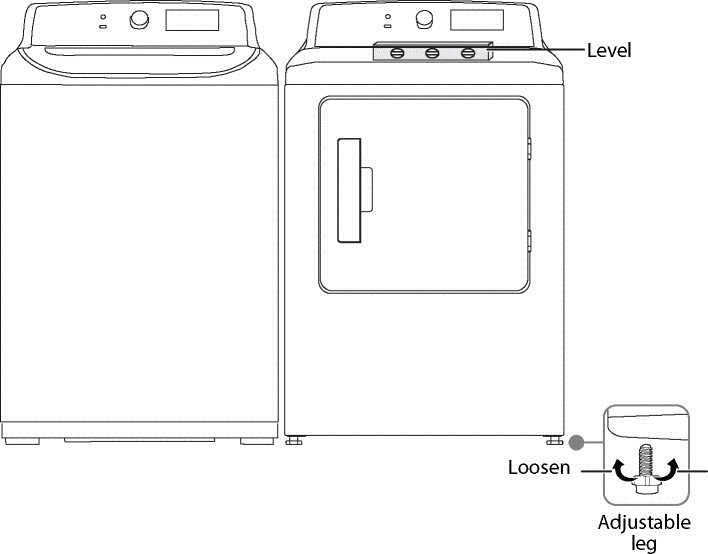
Step 6: Plug in your dryer
Make sure that all exhaust and electrical connections are complete, then plug your dryer into the electrical outlet.
Step 7: Check the final installation
• Before you use your dryer, make sure that:
• Your dryer is plugged into an electrical outlet and is properly grounded.
• You used rigid or stiff-walled flexible metal vent material. You did not use a plastic flexible ducting.
• The exhaust duct work is hooked up and the joints are taped.
• The dryer is level and sits firmly on the floor.
• Start your dryer to confirm that it runs, heats, and shuts off.
Reversing the dryer door
1 Make sure that the power cord is unplugged.
2 While supporting the door, remove the four hinge screws from the door, then lift the door to remove it and set the door aside.

CAUTION: Be careful not to drop the door when removing the screws.
3 Remove the screws for the locker cover on the right side of the dryer and the screws for the locker cover on the left side of the dryer.

4 Install the locker onto the right side of the dryer with the screws you just removed, then install the locker cover on the left side of the dryer.
5 Remove the screws around the door.
6 Pull the inside door board from the outside door board.

7 Rotate the inside door board 180°, then reassemble it with the outside door board with the screws you removed previously.
8 Install the hinges onto the left side of the dryer.
9 Align the hinges on the door with the hinge screw holes on the front of your dryer, then secure the door with the four screws you previously removed.
Using your dryer
Drying a load of clothes
Step 1: Turn on your dryer
• Press the  /POWER button to turn on your dryer.
/POWER button to turn on your dryer.
Step 2: Load your dryer
• Place only one wash load in your dryer at a time.
• Heavy and light weight fabrics take different amounts of time to dry. If you mix heavy and light weight fabrics in a load, lightweight fabrics may be dry at the end of the cycle while heavy fabrics may still be damp.
• If you only need to dry one or two items, you can improve the tumbling action and drying efficiency by adding a couple of similar items to the load.
• Overloading restricts tumbling action which results in uneven drying and excessive wrinkling of some fabrics.
Step 3: Select the dryer cycle and options
1 Turn the Cycle Selector to select a drying cycle. For more information, see Dryer options and settings on page 24.

2 Optional: Use the control panel buttons (like Wrinkle Prevent) to customize the drying cycle. For descriptions of buttons, see Control panel on page 7. For information about which buttons are available for each cycle type, see Dryer options and settings on page 24.
3 Optional: After you select a drying cycle and customize the cycle, press and hold the MY CYCLE button for three seconds to save your settings. The light next to the knob flashes and your dryer beeps three times to confirm that your settings are saved.
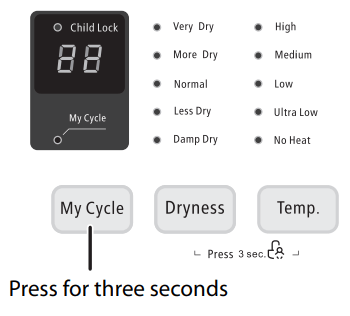
When you want to use your saved cycle and settings again, press the MY CYCLE button.
Step 4: Start your dryer
1 Press the  START PAUSE button.
START PAUSE button.
2 If you need to pause the cycle (for example to add or remove items or adjust the load), press the  START PAUSE button, then open the door. Your dryer stops tumbling. When you are ready to start drying again, close the door, then press the
START PAUSE button, then open the door. Your dryer stops tumbling. When you are ready to start drying again, close the door, then press the  START PAUSE button.
START PAUSE button.
Note: During the initial use of your new gas or electric dryer, you may notice an odor that has an oily or burning smell. This odor is considered normal and may be emitted as the natural oils deposited from human hands during product assembly or dust accumulated on various mechanical parts burns off during initial operation.
Unloading your dryer
1 When the drying cycle is over, your dryer beeps six times and the Clean Filter indicator lights.

2 Open the door and remove the items.
Note: You should clean the lint filter after every load to avoid lint buildup and to make sure that your dryer is running efficiently. See Cleaning the lint filter on page 23.
Setting the child lock
Your dryer has a child lock feature to prevent children from playing with your dryer. When you turn on the child lock, the only button that works is  /POWER.
/POWER.
• You can turn on your dryer, set this function, then turn it off.
• When you do so, even if the unit is powered on, you still cannot start it before the Child Lock function is deactivated.
• This function is cancelled automatically if your unit is out of power, such as when you unplug it or the power turns off.
1 Press and hold both the Dryness and Temp buttons for three seconds. The blue child lock light turns on.
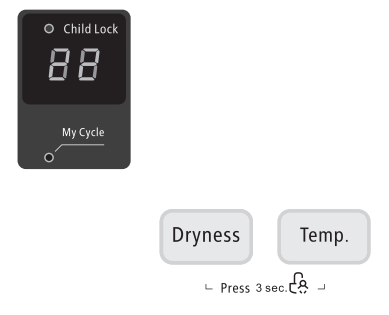
2 To turn off the child lock, press and hold both the Dryness and Temp buttons for three seconds.
Cleaning the lint filter
WARNING: Do not operate your dryer without the lint filter in place.
Note:
• You should clean the lint filter after every load to shorten the drying time and to make sure that your dryer is running efficiently.
• If the lint is difficult to wipe away, you can gently wash the filter in mild, soapy water. Make sure that you rinse all the soap off the filter and that the filter is dry before you put it back into your dryer.
• Gently pull the lint filter out of the slot at the bottom of the drum. Remove the accumulated lint, then insert the filter back into the slot.
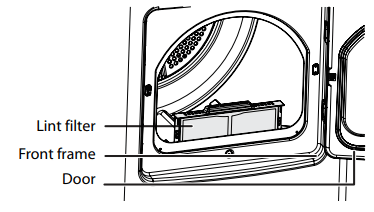
Maintaining your dryer
Cleaning the exterior
• Clean with a soft, damp cloth. Do not use abrasive substances.
• Protect the surface from sharp objects.
• Do not place any heavy or sharp objects or a detergent box on the dryer. Keep them in a separate storage area. These items may scratch or damage the top cover of the dryer.
• Because the entire dryer has a high-gloss finish, the surface can be scratched or damaged. Avoid scratching or damaging the surface when using the dryer.
Cleaning the drum
• Clean with a damp cloth dampened with a mild, non-abrasive cleaner suitable for stainless steel and anodized surfaces.
• Remove the cleaner residue and dry with a clean cloth.
Cleaning the control panel
• Clean with a soft, damp cloth. Do not use abrasive substances.
• Do not spray cleaners directly on the panel. The control panel finish may be damaged by some laundry pre-treatment soil and stain remover products. Apply such products away from your dryer and wipe up any spills or over-spray immediately.
Cleaning and inspecting the exhaust system
Inspect and clean the exhaust yearly to maintain optimum performance.
- Disconnect the exhaust duct from the dryer and from the exhaust hood (at the exhaust outlet) outside of the building.
- Check the interior of the duct and remove any lint accumulation.
- Make sure that lint is removed from the exhaust hood. Lint may collect in the exhaust hood so that the flappers or louvers will not open or close completely.
- After cleaning the exhaust hood, check that the flapper or louvers move freely.
- Reassemble the exhaust duct and hood, making sure that the joints are secure and sealed. 6 Operate your dryer and make sure that the exhaust air is not obstructed in the vent and that there are no leaks in the system.
Troubleshooting
CAUTION: Do not try to repair your dryer yourself. Doing so invalidates the warranty.
PROBLEM | SOLUTION |
Dryer does not start. | • Confirm that the Child Lock is not on. • Make sure the dryer door is closed completely. • If you opened the door during the drying cycle, press the • Make sure that the power cord is plugged into a working electrical outlet. • Check the circuit breaker and fuses for your dryer's electrical connection. |
Dryer does not heat or does not dry. | • Your dryer may have moved into the cool-down process of the cycle. This is normal. • Select a cycle other than Air Fluff and a temperature setting that is not "no heat." • Do not overload your dryer. Depending on the size of your washer, one wash load should equal one dry load. • Dry heavy items and lightweight items separately. • If you are drying large, bulky items, like blankets or comforters, try repositioning the load to ensure even drying. • The load may be too small to tumble correctly. Add a few towels. • Clean the lint filter and exhaust duct. • Check the circuit breaker and fuses for your dryer's electrical connection. • Make sure that the outside exhaust hood opens and closes freely. • Check the exhaust system for lint buildup. Ducting should be inspected and cleaned annually. • Make sure that your exhaust duct is a 4" rigid metal duct. |
Dryer is noisy. | • It is normal for your dryer to hum due to the high velocity of air moving through the dryer drum and exhaust system. • Check the load for objects, like coins, loose buttons, nails, or broken zippers. Remove these items. • Make sure that your dryer is level. |
Clothes are unevenly dried. | • Seams, pockets, and other similarly heavy areas may not be completely dry when the rest of the load has reached the selected dryness level. This is normal. Select the More or Very dryness level if desired. • If you dry one heavy item with a lightweight load (such as one towel with sheets), the heavy item may not be completely dry when the rest of the load has reached the selected dryness level. For best drying results, dry heavy items and lightweight items separately. |
Dryer shuts off before clothes are dried. | • The dryer load is too small. Add more items or a few towels and restart the cycle. • The dryer load is too large. Remove some items and restart the cycle. |
Dryer has an odd odor. | • Your dryer draws air from the surrounding room air. Household odors from paint, varnish, strong cleaners, and so forth, may enter your dryer with the surrounding room air. This is normal. When these odors linger in the air, ventilate the room completely before using your dryer. |
Odor remains in clothing even after washing. | • Fabrics containing strong odors should be rewashed utilizing desired wash cycle. |
Clothing is still wrinkled after using the Wrinkle Prevent setting. | • Small loads of one to four items work best. • If the dryer load is too large, items cannot tumble freely. Try loading fewer items. • Make sure that the items in the dryer load are similar. The Wrinkle Prevent setting works best when the items in the dryer load are similar-type items. |
There is lint on the clothing. | • Check pockets thoroughly before washing and drying clothes. Things like paper or tissue can break up into small pieces that turn into lint. • Clean the lint filter before every cycle. Some loads that produce high amounts of lint can clog the filter. • Some fabrics are lint producers (like a fuzzy white cotton towel) and they should be dried separately from clothes that are lint trappers (like a pair of black linen pants). • Divide larger loads into smaller loads for drying. |
Understanding the error codes
Your dryer is equipped with an automatic error-monitoring system to detect and diagnose problems at an early stage.
ERROR CODE | POSSIBLE CAUSE | SOLUTIONS |
C9 | The PCBs failed. | Contact authorized service personnel for help. DO NOT use your dryer. |
E4 | The humidity sensor failed. | Your dryer will complete the current operating cycle but items could be over dried. Your dryer can still operate under the Time cycles. Contact authorized service personnel for help. |
E5 | The temperature sensor failed. | Contact authorized service personnel for help. DO NOT use your dryer. |
See other models: NS-IMP26SS7 NS-WC29SS9 NS-IR10BK6 NS-DS9PDVD15 NS-AF53DSS0
